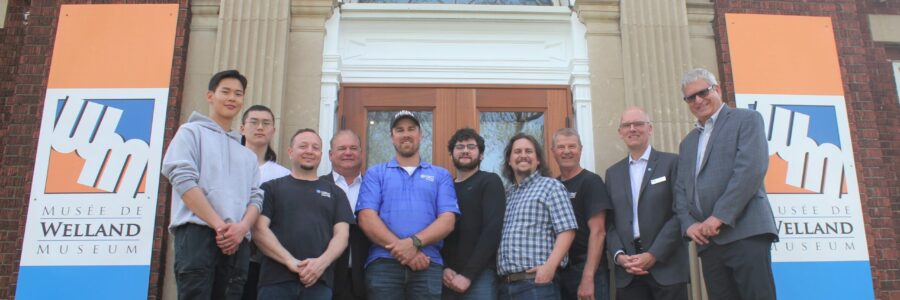If you drive by the museum in Welland, you might find yourself doing a double take.
On May 12, a set of replica doors were unveiled on the front of the Carnegie building – home to the former library built in 1923 – in honour of its 100th anniversary.
The doors were designed and crafted by faculty and students in Niagara College’s School of Trades, with custom work by carpentry and welding experts based on the original blueprints.

Jeff Burch, MPP of Niagara Centre, cuts the ribbon at the unveiling of the new, made-at-NC doors to the Welland Museum. Burch is pictured with Greg D’Amico, Chair of the museum.
Their work was celebrated at the unveiling event, attended by Jeff Burch, MPP for Niagara Centre, representatives from the Ontario Trillium Foundation, Bonnie Fokkens, Councillor for the City of Welland, Julianne Brunet, CEO of the Welland Library, and Greg D’Amico, Chair of the Welland Museum. Members of the College’s Executive Team, faculty, and students also attended.
“The Museum is very impressed with the work done by Niagara College for the reconstructed doors. The building has now been restored to its original grand appeal,” said Chair D’Amico. “It has been such a bonus for us to work with Niagara College for this project and we look forward to a continued partnership with them.”
“Niagara College is passionate about and embedded in the communities we serve, and we are honoured to support the efforts of the Welland Museum to bring the history of our community to life,” said Jeff Murrell, Associate Dean of the School of Trades. “We are proud of the remarkable students and faculty in our School of Trades who lent their time and talents to this one-of-a-kind restoration project.”
The collaborative project was led by Carpentry and Renovation professor Alexander Lukacs, lab technician Marco Giorgi, and a team of student volunteers – in partnership with Weldingprofessors Brendan Ryan, Vic Barker and technologist Bob Lukacs – who devoted their time to this community project.
Lukacs – a professional carpenter-turned-educator with over 17 years’ experience – jumped at the chance to work on the doors which he described as a “once-in-a-lifetime” restoration project. He saw the potential for his students to have a unique learning opportunity to advance their skills, try out new techniques, and work with premium construction materials.
“It was an incredible experience to watch these students progress over two years and see them build their confidence on such a complex project,” said Lukacs. “Our students are the reason we are here; we cannot operate without them and so it is our duty to provide them the best education we can.”
- Patrick Silva sands the Sapele wood boards used to make the doors.
- Evan Kim and Dongwoo Kang working on a cabinetry project for the Welland Museum.
- Jose Antonio Sandoval Sanchez with professor Alex Lukacs in the College’s carpentry lab.
Carpentry and Renovation Technician students Dongwoo Kang and Hyuk (Evan) Kim from South Korea, Patrick Silva from Hamilton, and Jose Antonio Sandoval Sanchez from Guatemala volunteered their time to work with Lukacs after class.
In addition to donating the material costs, the NC team devoted over 200 hours to the project. This included the artful construction of the frame from sapele wood, artisanal millwork to the trim, installation of shatterproof lexan glass, and custom welding work to create the mail slot, handles, and hinges.
Silva heard about the project from a friend in Lukacs’s class and was eager to get involved.
“This project reinvigorated my interest in historic restoration projects and more artistic work in fine carpentry,” Silva explained as he helped with laminating and milling the boards for the doors.
For Silva, the true value in the project was the one-on-one instruction and the chance to give back to a local organization.
“I’ve learned a lot from Alex in a short amount of time. It means a lot to us as students because we’ve had the chance to experience his expertise in a unique way,” said Silva. “Alex will sit down with you until you get it right, no matter how long it takes.”
- The handles and letter place slots.
- Thumb lever
- Mail slot scroll making.
In the welding lab, Ryan and the team took inspiration from old photos. They incorporated metal work and blacksmithing techniques to construct the mail slot, handles, and hinges from mild steel, aging the plates to create an antiqued, weathered look to fit the era of the building.
Ryan explained how the team used welding techniques to create the illusion that pieces were cast as they would have been at the time the doors were originally built. As a final step, the pieces were painted black.
While the mail slot and door are purely decorative, Ryan welcomed the chance to collaborate with colleagues, problem-solve, and apply skills – like scroll-making by hand – that he brings from industry.
“Every time we get together, we learn something from each other or from a different trade,” said Ryan. “We learn about ourselves through a challenge like this project, and those ‘aha’ moments when you make something work.”
Earlier in the Winter Term, the NC team designed and constructed three moveable display cabinets that are being used inside the Welland Museum. The cabinets were secured to a welded frame to ensure stability and have hidden wheels so the cabinets can function as movable walls. They were designed with a dark brown, American walnut frame to match the rustic building interior.
- Dongwoo Kang spray-painting the displays.
- Professor Alex Lukacs explaining the technique to spray paint and finish the display cabinets.
Kim and Kang applied skills from their second-year Architectural Millwork course to sand, glaze, spot-putty and spray paint the cabinets. Kim, who came to NC following time in the military back home, hopes to do renovation work. Kang has his sights on cabinet-making.
A truly made-at-NC project from design to construction to delivery, the doors have opened to a great community partnership and represent the impact that students have in our community.
Niagara College has a full-time enrolment of more than 10,000 students from over 95 countries, who study in 130 diploma, certificate and bachelor degree programs at specialized campuses in Welland and Niagara-on-the-Lake. Niagara College is also involved in educational projects and partnerships around the world and is consistently ranked among Canada’s top 10 colleges for research funding. Learn more at niagaracollege.ca.
 Back to myNiagaraOnline
Back to myNiagaraOnline































